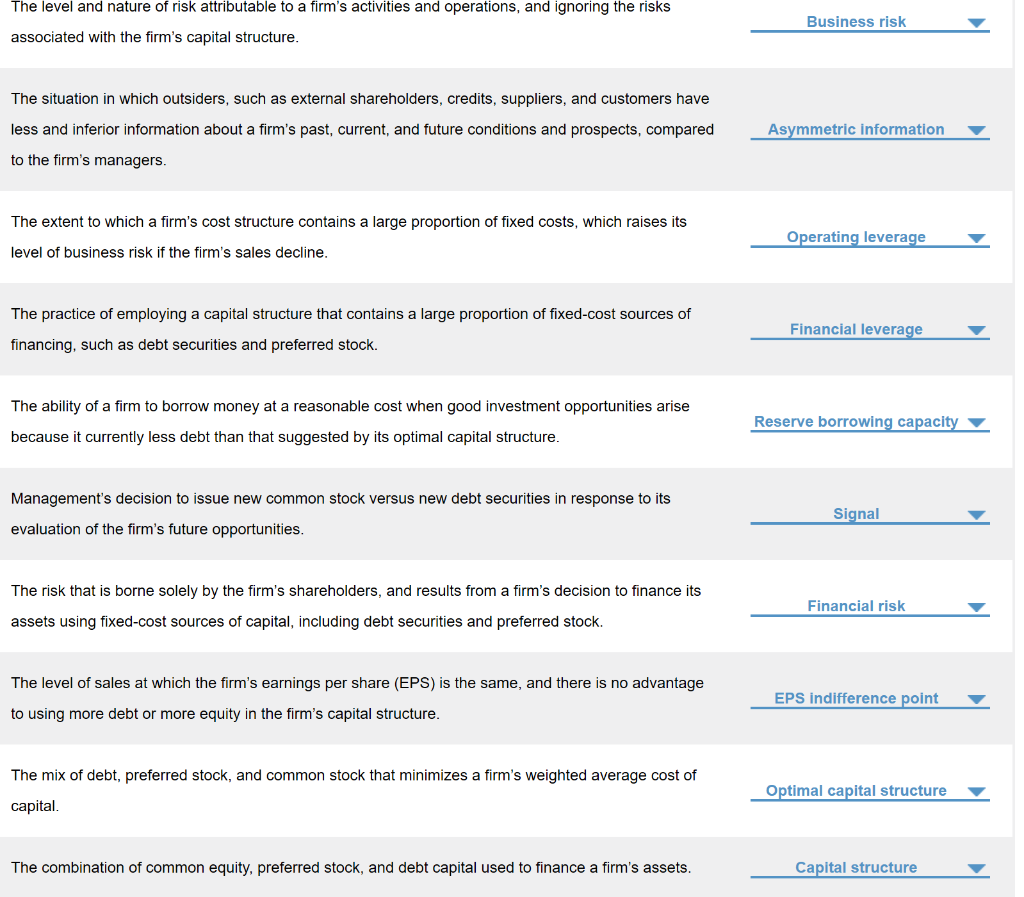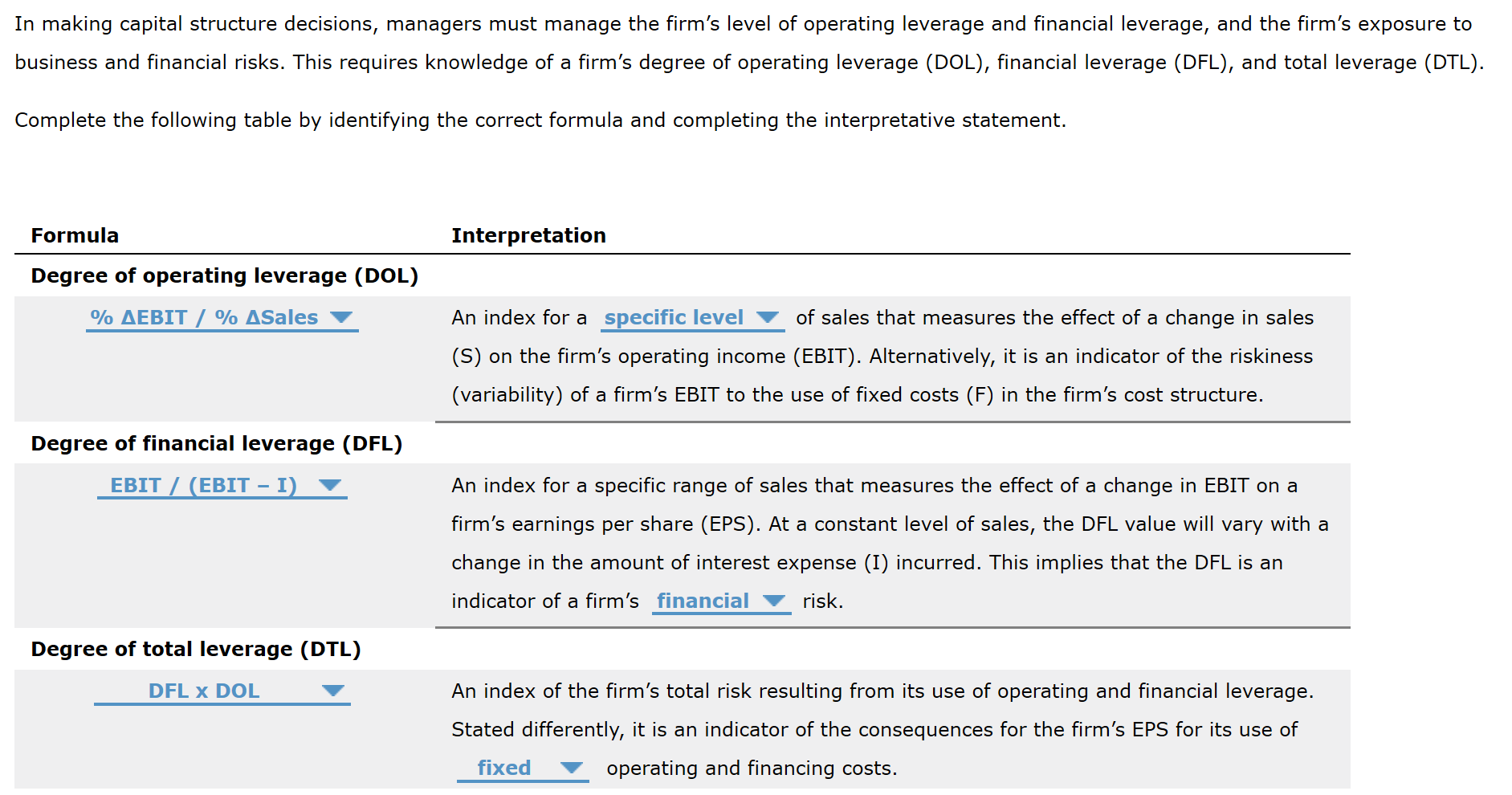

The level and nature of risk attributable to a firm's activities and operations, and ignoring the risks associated with the firm's capital structure. Business risk The situation in which outsiders, such as external shareholders, credits, suppliers, and customers have Asymmetric information less and inferior information about a firm's past, current, and future conditions and prospects, compared to the firm's managers. The extent to which a firm's cost structure contains a large proportion of fixed costs, which raises its Operating leverage level of business risk if the firm's sales decline. The practice of employing a capital structure that contains a large proportion of fixed-cost sources of Financial leverage financing, such as debt securities and preferred stock. The ability of a firm to borrow money at a reasonable cost when good investment opportunities arise Reserve borrowing capacity because it currently less debt than that suggested by its optimal capital structure. Management's decision to issue new common stock versus new debt securities in response to its Signal Signal evaluation of the firm's future opportunities. The risk that is borne solely by the firm's shareholders, and results from a firm's decision to finance its assets using fixed-cost sources of capital, including debt securities and preferred stock. Financial risk The level of sales at which the firm's earnings per share (EPS) is the same, and there is no advantage to using more debt or more equity in the firm's capital structure. EPS indifference point The mix of debt, preferred stock, and common stock that minimizes a firm's weighted average cost of Optimal capital structure capital The combination of common equity, preferred stock, and debt capital used to finance a firm's assets. Capital structure In making capital structure decisions, managers must manage the firm's level of operating leverage and financial leverage, and the firm's exposure to business and financial risks. This requires knowledge of a firm's degree of operating leverage (DOL), financial leverage (DFL), and total leverage (DTL). Complete the following table by identifying the correct formula and completing the interpretative statement. Formula Interpretation Degree of operating leverage (DOL) % AEBIT / % ASales An index for a specific level of sales that measures the effect of a change in sales (s) on the firm's operating income (EBIT). Alternatively, it is an indicator of the riskiness (variability) of a firm's EBIT to the use of fixed costs (F) in the firm's cost structure. Degree of financial leverage (DFL) EBIT / (EBIT - I) An index for a specific range of sales that measures the effect of a change in EBIT on a firm's earnings per share (EPS). At a constant level of sales, the DFL value will vary with a change in the amount of interest expense (I) incurred. This implies that the DFL is an indicator of a firm's financial risk. Degree of total leverage (DTL) DFL X DOL An index of the firm's total risk resulting from its use of operating and financial leverage. Stated differently, it is an indicator of the consequences for the firm's EPS for its use of fixed operating and financing costs. The level and nature of risk attributable to a firm's activities and operations, and ignoring the risks associated with the firm's capital structure. Business risk The situation in which outsiders, such as external shareholders, credits, suppliers, and customers have Asymmetric information less and inferior information about a firm's past, current, and future conditions and prospects, compared to the firm's managers. The extent to which a firm's cost structure contains a large proportion of fixed costs, which raises its Operating leverage level of business risk if the firm's sales decline. The practice of employing a capital structure that contains a large proportion of fixed-cost sources of Financial leverage financing, such as debt securities and preferred stock. The ability of a firm to borrow money at a reasonable cost when good investment opportunities arise Reserve borrowing capacity because it currently less debt than that suggested by its optimal capital structure. Management's decision to issue new common stock versus new debt securities in response to its Signal Signal evaluation of the firm's future opportunities. The risk that is borne solely by the firm's shareholders, and results from a firm's decision to finance its assets using fixed-cost sources of capital, including debt securities and preferred stock. Financial risk The level of sales at which the firm's earnings per share (EPS) is the same, and there is no advantage to using more debt or more equity in the firm's capital structure. EPS indifference point The mix of debt, preferred stock, and common stock that minimizes a firm's weighted average cost of Optimal capital structure capital The combination of common equity, preferred stock, and debt capital used to finance a firm's assets. Capital structure In making capital structure decisions, managers must manage the firm's level of operating leverage and financial leverage, and the firm's exposure to business and financial risks. This requires knowledge of a firm's degree of operating leverage (DOL), financial leverage (DFL), and total leverage (DTL). Complete the following table by identifying the correct formula and completing the interpretative statement. Formula Interpretation Degree of operating leverage (DOL) % AEBIT / % ASales An index for a specific level of sales that measures the effect of a change in sales (s) on the firm's operating income (EBIT). Alternatively, it is an indicator of the riskiness (variability) of a firm's EBIT to the use of fixed costs (F) in the firm's cost structure. Degree of financial leverage (DFL) EBIT / (EBIT - I) An index for a specific range of sales that measures the effect of a change in EBIT on a firm's earnings per share (EPS). At a constant level of sales, the DFL value will vary with a change in the amount of interest expense (I) incurred. This implies that the DFL is an indicator of a firm's financial risk. Degree of total leverage (DTL) DFL X DOL An index of the firm's total risk resulting from its use of operating and financial leverage. Stated differently, it is an indicator of the consequences for the firm's EPS for its use of fixed operating and financing costs








